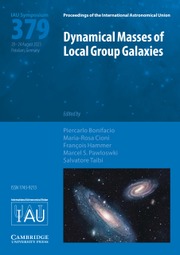No CrossRef data available.
Article contents
Equilibrium dynamical models for the Large Magellanic Cloud
Published online by Cambridge University Press: 30 October 2025
Abstract
The Large Magellanic Cloud (LMC) has a complex dynamics driven by both internal and external processes. The external forces are due to tidal interactions with the Small Magellanic Cloud and the Milky Way, while internally its dynamics mainly depends on the stellar, gas, and dark matter mass distributions. Despite the overall complexity of the system, very often simple physical models can give us important insights about the main driving factors. Here we focus on the internal forces and attempt to model the proper motions of ∼ 106 stars in the LMC as measured by Gaia Data Release 3 with an axisymmetric dynamical model, based on the Jeans equations. We test both cored and cusped spherical Navarro-Frenk-White dark matter halos to fit the LMC gravitational potential. We find that this simple model is very successful at selecting a clean sample of genuine LMC member stars and predicts the geometry and orientation of the LMC with respect to the observer within the constraint of axisymmetry. Our Jeans dynamical models describe well the rotation profile and the velocity dispersion of the LMC stellar disc, however they fail to describe the motions of the LMC bar, which is a non-axisymmetric feature dominating the central region. We plan a triaxial Schwarzschild approach as a next step for the dynamical modelling of the LMC.
Keywords
Information
- Type
- Contributed Paper
- Information
- Proceedings of the International Astronomical Union , Volume 19 , Symposium S379: Dynamical Masses of Local Group Galaxies , December 2023 , pp. 25 - 31
- Copyright
- © The Author(s), 2025. Published by Cambridge University Press on behalf of International Astronomical Union


